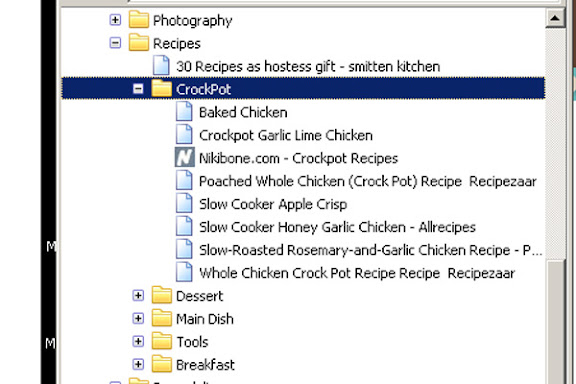I find a lot of people struggling with how to organize their recipes. Some keep it all electronic, some keep it all on paper. I have a mix of the two. I would love to be 100% electronic, but my kitchen is a little short on counter space, and I'm very messy when I cook. My kitchen is no place for my laptop. ;-)

I get my recipes from a variety of sources. Online recipes that I have yet to make are stored one of two ways. All other recipes, plus online ones that I have made and like, are filed in a binder and then listed in a central excel spreadsheet for easy viewing (more on that later). Let's start with online organization:
Online Blogs: When I see a recipe I like, I subscribe to the blog in Google Reader (if I haven't already) and then star the recipe as well as add tags. I like to add tags based on ingredients (chicken, cream cheese, banana), as well as, category and subcategory of items (Dinner, Dessert, Cupcake, Burgers). This helps me both when I'm looking for dinner ideas and when I'm trying to figure out what the heck to do with extra cream cheese.
 Other Online Recipe Sites
Other Online Recipe Sites: I bookmark other sites in categorized folders, and edit the title so the recipe name is readily visible when I view my bookmarks.

Now, as I mentioned, the other recipes are all listed in one central excel worksheet. I do this so I can quickly and easily search for ideas based on ingredients or categories.
Magazines: I currently subscribe to Cooks Illustrated and Everyday Food. When each issue arrives, I open up the excel spreadsheet and start flipping through the magazine. Anything that looks like something we'd like gets added to the spreadsheet, with "MAKE" listed in the column for Rating. If there is only one or two recipes of interest in a particular magazine, I'll just copy them over, being sure to include the original source, and keep them in the binder. No sense taking up all that space for just one or two ideas!
Cookbooks: I have a number of cookbooks, and each one has been numbered with a little sticker for easy referencing. When I make something that I like from one of the cookbooks, it gets entered into the excel spreadsheet and the number of the book is used to identify which book it came from.
 The Binder:
The Binder: This houses recipes from friends and family, or tested
internet recipes. I received a box full of recipes at my bridal shower from all those in attendance - which was a great idea! They were all on 3x5 index cards, so I've continued with this pattern. When I am ready to try an online recipe, I copy it down on a 3x5 card and use that in the kitchen. If we love the recipe, I add it to the excel spreadsheet and give it a home in the binder. The binder is organized by the following categories: Appetizer, Bread, Breakfast, Dessert, Fish, Pasta, Poultry, Sauces, Vegetarian, and Drinks.

I got some
4x6 photo sheet protectors and can fit 8 recipes per sheet. The one problem there that I didn't foresee is that the sheet protectors are as long as the tabs on the dividers, so you can't see them all. Not a huge deal for me. These are all loaded in 1" binder (for now!) with a flexible binding so I can fold it over and use in my cookbook holder in the kitchen.
Crockpot recipes are stored similarly, in a separate binder. (very soon the label maker will make it's presence known to the binder!)
 The Spreadsheet:
The Spreadsheet: The excel spreadsheet lists all tested recipes, plus any that are in the binder that I have yet to make. There are six columns:
~Recipe - the name of the recipe
~Location - Where it is stored.
BPL26 stands for Binder, Poultry, 26
th slot (yes, that's specific, but when you have 50 some odd recipes in that category, you need more help narrowing it down!).
EF-59-70 stands for Everyday Food, Issue 59, page 70.
~Category - this relates to the section of the binder it is, or would be, located in. This is necessary for the recipes stored in cookbooks and magazines.
~Tags - here I indicate main dish, side, cupcake, ice cream, etc. It just gives me another angle to sort with... if I come in knowing I need a cupcake recipe, I can sort that column or search for cupcakes.
~Ingredients - Here I list many of the ingredients of the recipe, which helps in two ways. When perusing for dinner ideas, it's a quick way to see if I have what's necessary... fresh lemons for instance. It also acts as a search tool when I have a leftover ingredient and want to use it up.
~Rating - since I am only putting good recipes in the binder, it seems silly to have this, but I still like having a way to denote minor differences in preferences, or maybe recipes that could use some tweaking. I also use this column to specify which recipes have yet to me made, by entering "make" in this column.

Now, when it comes time to plan my meals for the weekend, I have three places to search. I can go to my cookbooks or Google Reader for new recipe ideas, or I can go to my excel spreadsheet and look up old favorites. Same goes for if I have a pesky cup of buttermilk left and need to use it up. I hope this provides you with some ideas on how to better organize your recipes so THEY work for YOU!
































